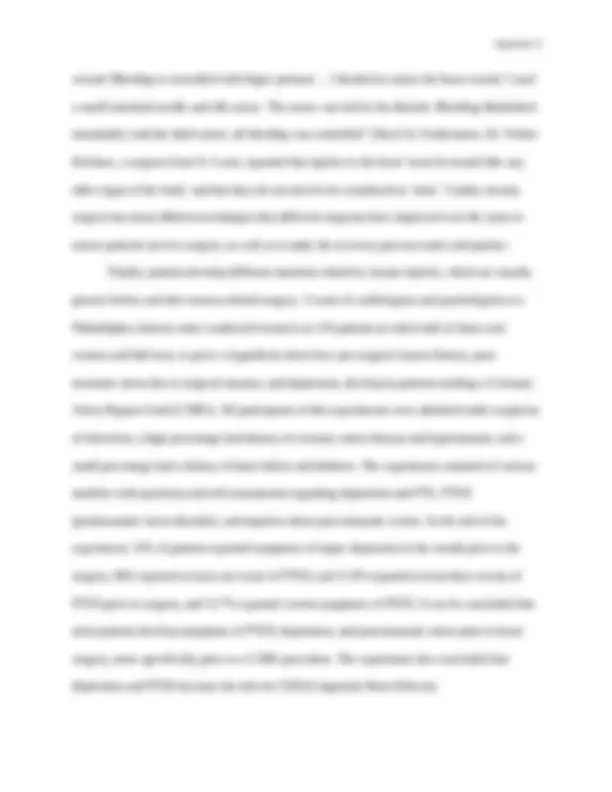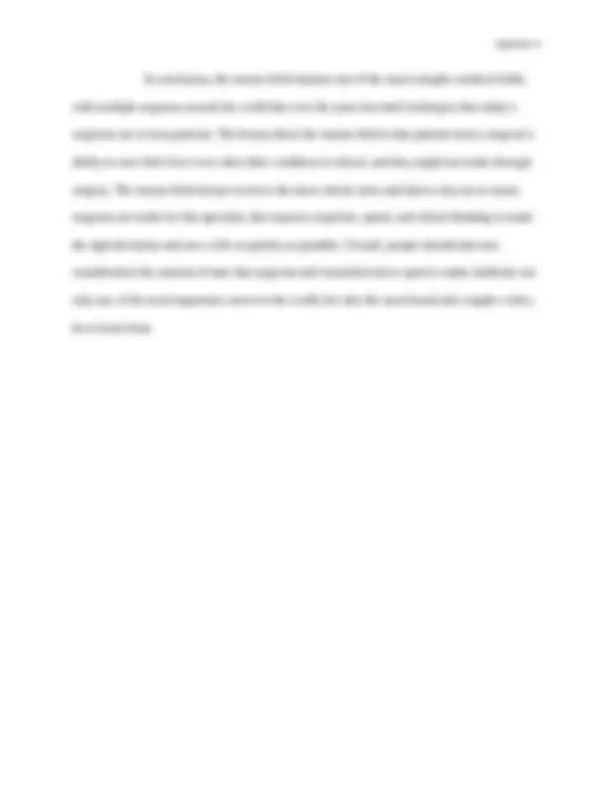





Study with the several resources on Docsity

Earn points by helping other students or get them with a premium plan


Prepare for your exams
Study with the several resources on Docsity

Earn points to download
Earn points by helping other students or get them with a premium plan
Community
Ask the community for help and clear up your study doubts
Discover the best universities in your country according to Docsity users
Free resources
Download our free guides on studying techniques, anxiety management strategies, and thesis advice from Docsity tutors
Informative essay about trauma field
Typology: Essays (university)
1 / 5

This page cannot be seen from the preview
Don't miss anything!




Luis Aparicio Professor Marion ENC- October 10th, 2022 Trauma Field. The Medical Specialty No One Talks About The medical field is one of the broadest career pathways in the world, each subspecialty and their roles are unique, and the trauma field remains one of the most important of them all. Trauma surgeons usually work to take care of critical injuries like gunshots, stabbing wounds, or other penetrating traumas that requires immediate medical attention, and today’s surgeons work with the most precise and advanced tools that years ago were not available or yet to be used in patients. Although the trauma field is one of the most difficult within medicine, it is important to know the history and different developments that surged along the way, and how a trauma injury makes patients develop different emotions. George Goodfellow, the first American civilian trauma surgeon. Goodfellow graduated in 1876 in the medical department at University of Wooster in Cleveland, Ohio, where he opened his first private practice. In 1880, he relocated to Tombstone, Arizona, where gunfights and thefts were common at the time, making the area both a dangerous place to live and the perfect place for him to earn his reputation as an expert in treating gunshot wounds and other injuries. After dealing with many cases of gunshot wounds, he decided to produce a new surgical technique: a laparotomy for trauma. A laparotomy is a surgical incision made for exploring internal injuries, therefore his intention was to operate on patients with abdominal wounds and repair their injuries from bullets. Some of the words he wrote shows that abdominal wounds need to be taken care of, otherwise the patient could bleed out, leading to death. “Seeing that he was
rapidly sinking, I determined to perform an operation, the feasibility of which I had been considering for some time, i.e., open the abdomen, clean it and sew up the intestinal wounds” (Duncan 156). Goodfellow also performed the first perineal prostatectomy on benign prostatic hyperplasia (enlarged prostate), at St Mary’s Hospital in 1891; he then traveled across the country to demonstrate this technique, operating on 78 patients. Moreover, Goodfellow also attempted to improve anesthesia practice and promoting usage of silk in body armor on the military to reduce the impact of gunshot wounds. He was denoted as the most skilled surgeon of his time. Multiple surgeons were known for making a series of contributions to cardiac trauma surgery on the 19th^ century. Barron Dominique Jean Larrey was a Surgeon-in-Chief of Napoleon’s imperial guard. He invented the first ambulance used to rescue wounded soldiers and he produced a way to triage patients based on severity. Larrey performed the first decompression of the pericardial sac by catheter drainage on a soldier who attempted suicide by stabbing himself in the chest. Gottard Bulau of Hamburg developed a technique of managing hemopneumothorax (blood around the thoracic cavity) and allowing the re-expansion of the lungs by a system of underwater drainage. In 1895, Ansel Cappelan of Norway performed the first suture of a human heart in a patient stabbed in the left chest with symptoms of cardiac tamponade (fluid around the heart). The heart was successfully sutured but the patient died due to other complications not related to the suture. Dr. Guido Farina of Rome sutured the right ventricle of the heart of a 30-year-old male stabbed in the right chest with a dagger; autopsy of the heart revealed perfect healing. The first successful cardiac repair was performed by Dr. Ludwig Rehn of Frankfurt, in 1896. Dr. Frankfurt received a patient with a penetrating wound to the upper right chest and an injury to the heart. “There is a 1.5 cm gaping right ventricular
In conclusion, the trauma field remains one of the most complex medical fields, with multiple surgeons around the world that over the years invented techniques that today’s surgeons use to treat patients. The beauty about the trauma field is that patients trust a surgeon’s ability to save their lives even when their condition is critical, and they might not make through surgery. The trauma field always receives the most critical cases and that is why not so many surgeons are made for this specialty, that requires expertise, speed, and critical thinking to make the right decisions and save a life as quickly as possible. Overall, people should take into consideration the amount of time that surgeons and researchers have spent to make medicine not only one of the most important careers in the world, but also the most broad and complex with a lot to learn from.
Works cited Nicol, A. J., et al. “History of Cardiac Trauma Surgery.” CME (Continuing Medical Education,): Continuing Medical Education , vol. 31, no. 6, June 2013, pp. 206–09. EBSCOhost Boyer, Bret, et al. “Appraisals of Fear, Helplessness, and Perceived Life-Threat During Emergent Cardiac Surgery: Relationship to Pre-Surgical Depression, Trauma History, and Posttraumatic Stress.” Journal of Clinical Psychology in Medical Settings , vol. 20, no. 2, June 2013, pp. 173–85. EBSCOhost , https://doi.org/10.1007/s10880-012-9330- Duncan, Rebecca E. “The Legacy of ‘The Gunfighters’ Surgeon’.” Trauma , vol. 17, no. 2, Apr. 2015, pp. 155–57. EBSCOhost , https://doi.org/10.1177/1460408614567705. Hung Lau, and Wai-Key Yuen. “Trauma: A Multidisciplinary Subspecialty.” Surgical Practice , vol. 9, no. 4, Nov. 2005, p. 115. EBSCOhost , https://doi.org/10.1111/j.1744- 1633.2005.00275.x.